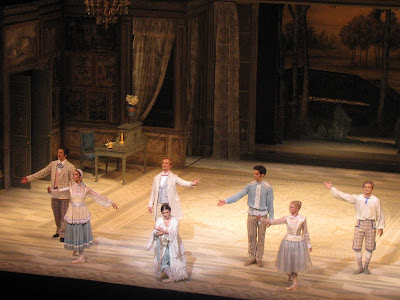The Royal Ballet, taking curtain calls in Frederick Ashton’s “A Month In The Country”.
In 1976, Ashton distilled Turgenev’s five-act play into a forty-minute ballet.
“A Month In The Country” was recognized as a masterpiece on opening night—and instantly became a permanent fixture of the Royal Ballet repertory. I believe it would be fair to characterize “A Month In The Country” as now a signature piece for the Royal Ballet.
“A Month In The Country” was Ashton’s first important ballet since “Enigma Variations”, created in 1968. It was to be the choreographer’s last work of significance; nothing Ashton created in the final dozen years of his life proved durable—or even interesting.
“A Month In The Country” may be the most subtle, complex ballet ever created. The evocation of character is amazing in its nuance; the portrayal of emotion has a thousand shadings. Turgenev’s entire story is presented, clearly and concisely, in a series of solos and pas de deux. The choreography is brilliant, the storytelling masterful. The ballet is a work of genius.
Julia Trevelyan Oman’s stage designs and costume designs matched Ashton’s subtlety. I have never seen a more beautiful or better-designed ballet setting.
“A Month In The Country” has long been familiar to audiences on the Eastern Seaboard. The Royal Ballet, in tours to the U.S., has presented the work in New York and Washington countless times since 1981, the year the company first brought “A Month In The Country” to America.
However, it was only in 1995 that a second company took up the work. The National Ballet Of Canada added “A Month In The Country” to its repertory that year. The reception—both by the Canadian press and by the Canadian public—was cautious, even chilly. Oman’s designs were singled out for being too detailed and too elaborate; more than one Canadian reviewer described them as unattractive.
Last month, a third company added “A Month In The Country” to its repertory. In the third week of May, American Ballet Theatre presented four performances of the work in New York. The public reception was overwhelming (although I have been told by persons whose opinions I respect that ABT’s casting was spotty).

No comments:
Post a Comment